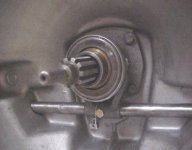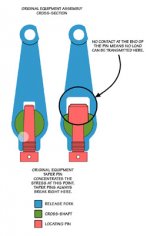Hello, I am a newby TR6 owner having just purchased a '76 TR6 a few weeks ago. The car has undergone an extensive restoration and has been mostly mechanically rebuilt by the appropriate Triumph experts. I understand that the master and slave clutch cylinders are new.
After about an hour of driving yesterday, I came to a stop sign and depressed the clutch pedal. There was no resistance whatsoever and the pedal went straight to the floor. The clutch had been functioning well up until this point. I managed to nurse it into gear and drove about another 15 miles before finding an appropriate place to stop. Still no resistance in the pedal. I stopped the car and had a look around, expecting to see some leaking fluid. I also checked and functioned the pedal, thinking that it had perhaps become disconnected from the Master cylinder piston. Everything looked normal, so I put the top up and was getting on the phone with AAA for the ride home. I decided to give the clutch one more push and lo and behold RESISTANCE! The normal function seemed to return and I was able to drive the rest of the way home, not without some anxiety.
While I could certainly understand if a seal had gone bad in the master or slave resulting in a loss of hydraulic pressure which might explain the lack of resistance, I am baffled by the fact that whatever problem caused the resistance loss initially seemingly corrected itself after about 10 minutes at rest.
I am no mechanic and will be taking the car in. However, any thoughts to point me in the right direction would be greatly appreciated!
After about an hour of driving yesterday, I came to a stop sign and depressed the clutch pedal. There was no resistance whatsoever and the pedal went straight to the floor. The clutch had been functioning well up until this point. I managed to nurse it into gear and drove about another 15 miles before finding an appropriate place to stop. Still no resistance in the pedal. I stopped the car and had a look around, expecting to see some leaking fluid. I also checked and functioned the pedal, thinking that it had perhaps become disconnected from the Master cylinder piston. Everything looked normal, so I put the top up and was getting on the phone with AAA for the ride home. I decided to give the clutch one more push and lo and behold RESISTANCE! The normal function seemed to return and I was able to drive the rest of the way home, not without some anxiety.
While I could certainly understand if a seal had gone bad in the master or slave resulting in a loss of hydraulic pressure which might explain the lack of resistance, I am baffled by the fact that whatever problem caused the resistance loss initially seemingly corrected itself after about 10 minutes at rest.
I am no mechanic and will be taking the car in. However, any thoughts to point me in the right direction would be greatly appreciated!

 Hi Guest!
Hi Guest!

 smilie in place of the real @
smilie in place of the real @
 Pretty Please - add it to our Events forum(s) and add to the calendar! >>
Pretty Please - add it to our Events forum(s) and add to the calendar! >> 





 and thanks, Randall.
and thanks, Randall.